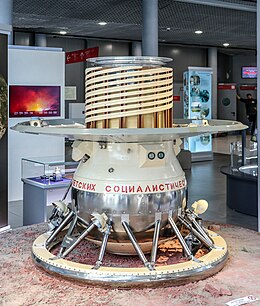 Model of Venera 9 lander | |
| Mission type | Venus orbiter / lander |
|---|---|
| Operator | Lavochkin |
| COSPAR ID | 1975-050A 1975-050D |
| SATCAT no. | 7915 8411 |
| Mission duration | Orbiter: 158 days Lander: 53 minutes Launch to last contact: 292 days |
| Spacecraft properties | |
| Spacecraft | 4V-1 No. 660 |
| Manufacturer | Lavochkin |
| Launch mass | 4,936 kg (10,882 lb)[1] |
| Landing mass | 1,560 kg (3,440 lb) |
| Payload mass | 660 kg (1,455 lb) |
| Start of mission | |
| Launch date | June 8, 1975, 02:38 UTC[2] |
| Rocket | Proton-K/D[2] |
| Launch site | Baikonur 81/24 |
| End of mission | |
| Last contact | Orbiter primary mission: March 22, 1976[3] Lander: October 22, 1975 |
| Orbital parameters | |
| Reference system | Cytherocentric |
| Eccentricity | 0.89002 |
| Pericytherion altitude | 7,625 km (4,738 mi) |
| Apocytherion altitude | 118,072 km (73,367 mi) |
| Inclination | 29.5 degrees |
| Period | 48.3 hours |
| Venus orbiter | |
| Spacecraft component | Orbiter |
| Orbital insertion | October 20, 1975 |
| Venus lander | |
| Spacecraft component | Lander |
| Landing date | October 22, 1975, 05:13 UTC |
| Landing site | 31°01′N 291°38′E / 31.01°N 291.64°E (near Beta Regio) |
 Stamp of Venera 9 | |
Venera 9 (Russian: Венера-9, lit. 'Venus-9'), manufacturer's designation: 4V-1 No. 660,[4] was a Soviet uncrewed space mission to Venus. It consisted of an orbiter and a lander. It was launched on June 8, 1975, at 02:38:00 UTC and had a mass of 4,936 kilograms (10,882 lb).[5] The orbiter was the first spacecraft to orbit Venus, while the lander was the first to return images from the surface of another planet.[6]
- ^ Siddiqi, Asif (2018). Beyond Earth: A Chronicle of Deep Space Exploration, 1958–2016 (PDF) (second ed.). NASA History Program Office.
- ^ a b McDowell, Jonathan. "Launch Log". Jonathan's Space Page. Retrieved April 11, 2013.
- ^ Siddiqi, Asif A. (2018). Beyond Earth: A Chronicle of Deep Space Exploration, 1958–2016 (PDF). The NASA history series (second ed.). Washington, DC: NASA History Program Office. pp. 127–128. ISBN 978-1-62683-042-4. LCCN 2017059404. SP2018-4041.
- ^ "History of the Venera 75 project". RussianSpaceWeb.com.
- ^ "Venera 9". NASA Space Science Data Coordinated Archive. Retrieved April 13, 2013.
- ^ "Solar System Exploration Multimedia Gallery: Venera 9". NASA. Archived from the original on August 3, 2009. Retrieved August 7, 2009.